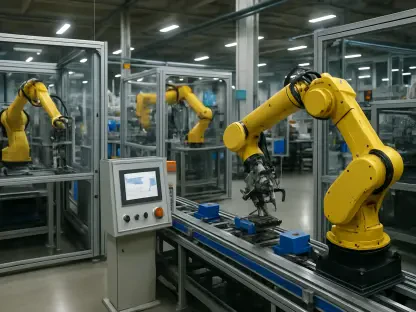Introduction to the AWS Outage and Tech Industry Context
The cloud computing industry serves as the backbone of the global digital economy, powering everything from streaming services to financial transactions with unmatched scale and efficiency across countless sectors. With businesses increasingly reliant on cloud infrastructure for data storage, application hosting, and real-time processing, any disruption sends shockwaves through various industries. Amazon Web Services (AWS), a leader in this space, supports numerous sectors, holding a significant market share and acting as the digital foundation for entertainment giants, fintech platforms, and government systems alike, making its stability absolutely critical.
Beyond Amazon, competitors like Microsoft Azure and Google Cloud Platform strive for dominance, each pushing boundaries with innovative offerings. The integration of artificial intelligence into cloud services marks a transformative trend, promising efficiency in operations and code development. However, as reliance on these technologies deepens, questions about resilience and risk emerge, setting the stage for critical discussions on how the industry balances innovation with reliability.
This report delves into a recent AWS outage that disrupted global services, exploring its implications against the backdrop of an industry racing toward AI-driven solutions. The reaction from tech mogul Elon Musk adds a layer of controversy, spotlighting debates over dependency on automated systems in critical infrastructure.
Details of the AWS Outage Event
Scope and Impact of the Disruption
On October 20, a major AWS outage struck the US-EAST-1 region in Northern Virginia, causing significant disruptions across core services such as EC2, S3, DynamoDB, and Lambda. Elevated error rates and latencies crippled operations for numerous platforms, exposing the fragility of interconnected digital ecosystems. The scale of this event reverberated through both Amazon’s internal offerings and external clients, underscoring the vast reach of a single regional failure.
Among the affected were Amazon’s own services like Prime Video and Alexa, alongside third-party applications including Snapchat, Fortnite, Coinbase, Duolingo, and The New York Times. This diverse impact highlighted how deeply embedded AWS is in daily digital life, from casual gaming to critical financial transactions. Downdetector recorded over 2,000 outage incidents across the United States, painting a stark picture of the disruption’s breadth and the immediate challenges faced by users and businesses.
The cascading effects revealed a sobering reality: a single point of failure in cloud infrastructure can halt operations for millions. Industries reliant on real-time data and uptime found themselves scrambling, with some unable to provide services for hours. This incident serves as a case study in the vulnerabilities of centralized systems, prompting scrutiny of dependency on major providers.
Amazon’s Response and Resolution
Amazon swiftly acknowledged the disruption, labeling it an “operational issue” and committing to a rapid resolution. Their public statement confirmed that the problem was fully mitigated, though specifics on the root cause remained limited. This transparency, while minimal, aimed to reassure stakeholders of their focus on restoring normalcy.
Behind the scenes, the company deployed multiple recovery strategies to address the outage, leveraging redundancies and technical expertise to minimize downtime. While the exact methods were not disclosed, the speed of recovery suggests robust contingency plans, a necessity for a provider of AWS’s stature. Such actions reflect an understanding of the high stakes involved when global services hang in the balance.
Nevertheless, the incident raises lingering concerns about trust in cloud platforms. Even with a quick fix, the outage eroded confidence among some users, particularly those in sectors where uninterrupted service is non-negotiable. The event fuels a broader conversation about how providers can guarantee reliability in an era of escalating demand and complexity.
Elon Musk’s Reaction and Critique
Elon Musk, known for his outspoken takes on technology, did not hold back in response to the AWS outage. Reposting a claim by the AWS CEO that 75% of Amazon’s production code is AI-generated, Musk quipped with a sarcastic “You don’t say.” This biting remark hinted at skepticism over the wisdom of leaning heavily on artificial intelligence for critical systems.
Musk’s commentary extends beyond this single jab, reflecting a deeper distrust of platforms tethered to AWS infrastructure. His past statements, including reservations about the security of apps like Signal—which also suffered during the outage—suggest a broader critique of centralized cloud dependency. While not explicitly tying AI to the outage, his words imply a cautionary stance on automation in high-stakes environments.
Within the tech community, Musk’s perspective stirs debate without necessarily swaying consensus. His influence ensures that such remarks gain traction, prompting discussions on whether AI integration might introduce unseen risks. This reaction, while subjective, adds a provocative dimension to the analysis of the outage, encouraging reflection on innovation’s limits.
Challenges in Cloud Computing and AI Integration
The AWS outage lays bare the inherent vulnerabilities of centralized cloud infrastructure, where a single regional hiccup can disrupt global operations. Such incidents highlight the danger of single points of failure, especially as businesses consolidate their digital assets with a handful of providers. The concentration of risk in this model demands attention as dependency grows.
Integrating AI into code generation and infrastructure management, while promising efficiency, introduces potential pitfalls. Automated systems, if not rigorously tested, may harbor errors or inefficiencies that compound during crises. The allure of speed and cost savings must be weighed against the possibility of systemic weaknesses that could amplify disruptions like the recent outage.
To counter these challenges, strategies such as diversifying cloud providers or bolstering failover mechanisms offer paths to resilience. Hybrid cloud approaches, where workloads are distributed across multiple platforms, could mitigate the impact of a single provider’s failure. Additionally, investing in robust backup systems and stress-testing AI tools before deployment might prevent future breakdowns, ensuring stability amid rapid technological shifts.
Regulatory and Security Considerations in Cloud Services
The regulatory landscape for cloud computing continues to evolve, with governments worldwide prioritizing data privacy and service uptime standards. Frameworks like the General Data Protection Regulation in Europe and various federal guidelines in the United States impose strict requirements on how providers handle sensitive information. Compliance is no longer optional but a cornerstone of operational legitimacy.
Security measures play an equally critical role in preventing and mitigating outages. Robust encryption, regular audits, and incident response protocols are essential to safeguard against both technical failures and cyber threats. Providers like AWS must continuously update their defenses to match the sophistication of potential risks, as any lapse could invite regulatory scrutiny or customer backlash.
Incidents such as the recent outage may shape future policies, pushing for stricter oversight or mandatory redundancy standards. Governments and industry bodies could collaborate to establish benchmarks for reliability, ensuring that digital infrastructure keeps pace with societal dependence. These developments would aim to fortify trust in cloud services, addressing gaps exposed by real-world disruptions.
Future Outlook for Cloud Computing and AI
As digital dependency intensifies, cloud services are poised for exponential growth, with projections indicating sustained expansion from this year through 2027. The role of AI in tech development will likely deepen, driving automation in areas from infrastructure management to customer support. This trajectory promises innovation but also necessitates caution to avoid overreach.
Emerging solutions, such as edge computing and advanced monitoring tools, could enhance system reliability by decentralizing workloads and predicting failures before they occur. However, the rapid adoption of untested technologies carries risks, including unforeseen bugs or scalability issues. Balancing speed with thorough vetting will be crucial for providers aiming to maintain uptime and trust.
Global economic conditions, shifting consumer expectations, and evolving regulations will further influence the industry’s path. Economic downturns might constrain budgets for cloud investments, while heightened demand for seamless digital experiences pushes providers to innovate. Regulatory changes could either spur progress through clear guidelines or hinder it with excessive constraints, shaping how the sector adapts over time.
Conclusion: Balancing Innovation and Stability
The AWS outage on October 20 proved to be a pivotal moment, exposing the fragility of global digital services and the far-reaching consequences of disruptions in cloud infrastructure. Elon Musk’s pointed critique of AI reliance sparked heated discussions, amplifying concerns about the intersection of cutting-edge tech and operational dependability. The event underscored the interconnectedness of modern systems, where a single failure rippled across diverse industries.
Moving forward, stakeholders must prioritize actionable measures to fortify cloud ecosystems, such as investing in multi-provider strategies and rigorous testing of AI-driven tools. Industry leaders should collaborate on establishing best practices for resilience, ensuring that innovation does not outpace stability. A proactive approach to regulatory alignment and security enhancements will also be vital to prevent similar incidents.
Ultimately, the lessons from this disruption highlight the urgent need for a framework that harmonizes technological advancement with robust safeguards. By addressing single points of failure and fostering transparent communication during crises, the cloud computing sector can rebuild confidence. These steps, if taken decisively, promise to guide the industry toward a future where reliability matches ambition.









